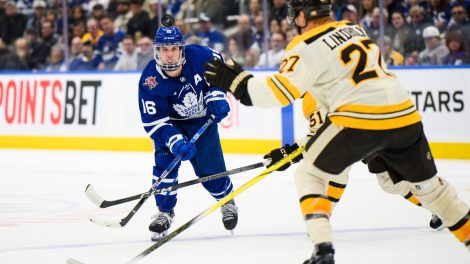VANCOUVER – Never have the Vancouver Canucks had so much money available for free agency, and rarely have they been less likely to spend it.
It’s not like they don’t have needs. The Canucks had to surge at the finish line this past season, going 5-1-1 amid the emotion of Danny and Hank Sedin’s final days in the National Hockey League, to end the year with 73 points – a whopping four-point improvement on their dismal previous campaign.
They’ve badly missed the playoffs in four of the last five years and just lost in the Sedin twins two of their best players and the team’s leadership and emotional epicentre. So, let’s just say there are some holes in the lineup.
But with an unprecedented (for the Canucks) wave of talented prospects steaming towards the NHL from Europe, junior and college hockey, most of the Canucks needs are short term. They need a top centre, but that could be Swedish sensation Elias Pettersson, the 19-year-old uber-prospect who is expected to play for the Canucks next fall, albeit as a winger to start. They need more scoring from the wings, but Kole Lind and Jonathan Dahlen are probably going to be a phone call – or one season – away in the American Hockey League.
[snippet id=3816507]
Vancouver’s goalie-of-the-future is minor-league star Thatcher Demko, who will push Canuck incumbents Jacob Markstrom and Anders Nilsson at training camp. Will Lockwood, Adam Gaudette and Jet Woo could eventually boost the grit factor. And even the critical need for a puck-rushing defencemen who can run a power play, which has been absent in Vancouver longer than affordable housing, appears to have been addressed with the drafting this month of University of Michigan dynamo Quinn Hughes.
With more than $24 million available in payroll, according to capfriendly.com, the Canucks could have afforded both John Tavares and Paul Stastny as free agents. Instead, they’re considering free-agent centres like Jay Beagle and Riley Nash as strategic acquisitions to play in the middle of the lineup and support the kids. But even their bloated values on July 1 may make little sense for the Canucks.
Three or four years from now, the Canucks expect some of their gifted prospects to have grown into primary roles. And Vancouver will need money to pay them. What the Canucks must do on Canada Day is not screw it up.
Sure, they can sign a couple of guys for experience and leadership, to help mentor and set an example for the youth movement well under way on the West Coast. But the last thing the Canucks should do is sign a marquee free agent to a four- or five-year contract when, really, what they need is a little help getting through the next season or two.
“We’ve gotten to a place now where we’ve got a very good group of exciting young players, and that continues to build,” Canuck president of hockey operations Trevor Linden told Sportsnet. “It’s just a matter of being patient and sticking with it now. July 1 is not a day to build. You can add some pieces. But if you look at good teams, the core is usually drafted.
“We need to think about getting better from within. We need to get our young players to take a step and be better. Our wins next year will be from the growth of young players. That’s where we are. July 1 isn’t a day where we’re going to build our team. It’s a patient day for us.”
Stinging from the $36-million-U.S. investment in free agent forward Loui Eriksson two years ago, the Canucks were preaching much the same message last summer. Then they signed five guys on July 1. But the longest contract they created was for three years, and the most expensive players were centre Sam Gagner ($3.15 million per season) and defenceman Michael Del Zotto ($3 million).
Linden and general manager Jim Benning could do something similar this weekend, except they won’t get close to last year’s volume of free agents unless they add forwards to help the Utica Comets’ rookies transition to pro hockey.
“It depends on term,” Linden said. “If you can sign a guy you really think can bridge you until some of these (prospects) are up and running, and play the right way and bring an element of stability to your lineup, there’s an argument to bringing a veteran in.
“But that’s not to say (a free agent) is going to block someone else from playing; if a young guy earns a spot, he’s going to be there. At the same time, we’ve got several first-year pros and there are only so many you can have on your NHL team. I don’t believe in ‘just let the kids play’ and throw them out there. That’s not a good recipe.
“If a kid comes in and shows he’s ready, that’s great. If he can’t, we have a great development program in Utica with (director of player development) Ryan Johnson and his group. That’s going to be a very important place and we’re spending a lot of time making sure we have a group down there that can bring these guys along. That’s as big a thought process for us as what’s happening in Vancouver.”
But for a franchise that spent the first decade of the salary-cap era doing accounting gymnastics to stay under the spending limit, isn’t it tempting to use their stack of available money and go all-in on one or two of the top free agents?
“It’s not tempting for me, not at all,” Linden said. “We need to be very prudent, thoughtful, of anybody we add that they fit into our group and our long-term plan.”
[relatedlinks]










